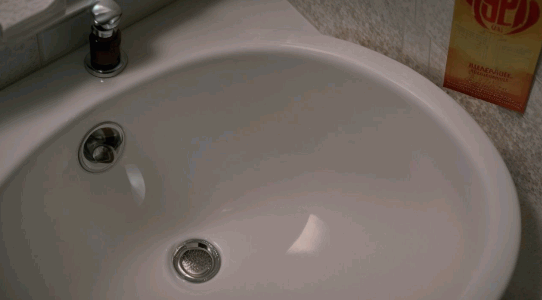Keeping your bathroom sink drain clean is essential for maintaining a healthy and hygienic environment in your bathroom. A clogged drain not only leads to unpleasant odors but also creates a breeding ground for bacteria and mold. In this comprehensive guide, we will discuss the importance of cleaning your bathroom sink drain and provide you with a detailed overview of the tools required for the job. From plungers to drain snakes, baking soda, and vinegar, we’ve got you covered. We will walk you through the step-by-step process of using these tools to effectively clean your bathroom sink drain. Whether you’re dealing with a minor clog or simply want to maintain a clean and odor-free drain, this article will equip you with the knowledge and techniques to keep your bathroom sink drain in top condition. So, let’s get started on the journey to a clean and functional bathroom sink drain!
Why Is It Important To Clean Bathroom Sink Drain?
It is crucial to regularly clean the bathroom sink drain to prevent clogs, maintain proper drainage, and eliminate unpleasant odors caused by grime, buildup, and bacterial growth.
By ensuring that the drain is clear of debris and blockages, the water can flow freely, allowing for efficient drainage and reducing the risk of standing water, which can attract bacteria and lead to unpleasant odors.
Regular drain maintenance also contributes to improving the overall cleanliness and hygiene of the bathroom sink area, creating a more pleasant and welcoming environment.
Neglecting drain maintenance can result in more severe issues like stubborn clogs, foul odors, and an environment conducive to bacterial growth, underscoring the importance of regular drain cleaning and maintenance in home improvement.
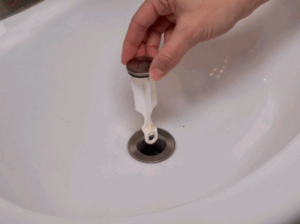
What Are The Tools Needed To Clean The Bathroom Sink Drain?
Cleaning drains at home requires essential tools and materials, as well as the choice between natural solutions and chemical alternatives.
A plunger is an indispensable tool for dislodging minor clogs, while a drain snake or auger can effectively clear more stubborn blockages. A drain brush and some protective gloves are necessary for thorough cleaning. Opting for natural solutions like vinegar, baking soda, or enzymatic cleaners can be safer for the environment, minimize exposure to harmful chemicals, and prevent potential damage to pipes, making them a popular choice for DIY home improvement projects.
Plunger
A plunger is a vital tool for clearing clogs in the bathroom sink drain, providing a simple and effective DIY solution for unclogging pipes and improving drainage.
When using a plunger, it’s important to ensure a tight seal between the plunger and the drain opening to create the necessary suction. Start by filling the sink with enough water to cover the rubber cup of the plunger. Position the plunger over the drain, then rapidly push and pull to create forceful pressure. This action helps dislodge the clog, allowing water to flow freely.
For more stubborn clogs, consider applying petroleum jelly to the rim of the plunger for a stronger seal and more effective unclogging.
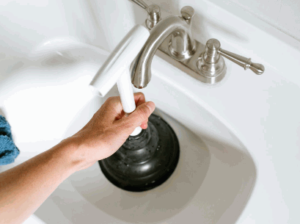
Drain Snake
Utilizing a drain snake is an effective method for removing stubborn clogs, especially those caused by hair and trapped debris within the bathroom sink drain, making it an essential tool for DIY home improvement.
The process of using a drain snake involves inserting the flexible, coiled wire into the drain and carefully navigating it through the pipes until it reaches the clog. Once located, the snake is manipulated to break up and dislodge the blockage, allowing water to flow freely again. Its versatility extends beyond bathroom sinks, as it can also be used to clear clogs in kitchen sinks, bathtubs, and shower drains, making it a valuable tool for maintaining clean and clog-free drains throughout the home.
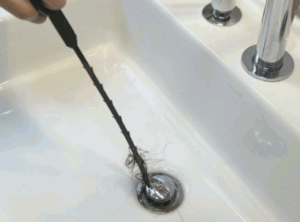
Baking Soda And Vinegar
The combination of baking soda and vinegar offers a natural and effective solution for cleaning and deodorizing the bathroom sink drain, making it an environmentally friendly DIY method for odor removal and maintenance.
This powerful duo works by creating a fizzing reaction that helps to break down and dissolve grime, grease, and residue that may be causing blockages or unpleasant odors in the drain.
Baking soda’s abrasive nature aids in scrubbing away buildup, while vinegar’s acidic properties help to neutralize foul smells.
This eco-friendly approach not only saves money but also reduces the need for harsh chemical cleaners, promoting a healthier living environment.
Learn more: How To Clean Drain With Vinegar
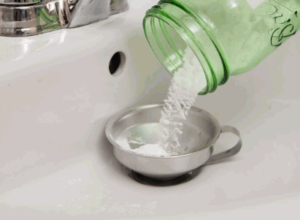
Hot Water
Flushing the bathroom sink drain with hot water serves as a simple and natural solution for clearing minor clogs, promoting smooth water flow, and eliminating lingering odors, aligning with DIY home improvement practices.
This eco-friendly method not only helps in maintaining the cleanliness and hygiene of the drain but also prevents the accumulation of debris and grime in the pipes, thus reducing the need for harsh chemical cleaners. Hot water effectively melts away grease and soap scum, preventing potential blockages and maintaining the overall integrity of the plumbing system. By making hot water flushes a regular part of pipe maintenance, homeowners can avoid costly repairs and contribute to a more sustainable and eco-friendly living environment.
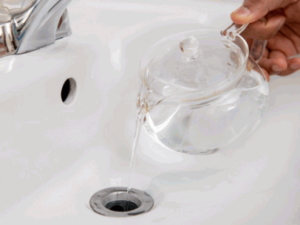
How To Clean Bathroom Sink Drain With Plunger?
Cleaning the bathroom sink drain with a plunger involves several steps to effectively unclog the drain, restore proper water flow, and maintain hygiene, making it a valuable DIY home improvement technique.
- To start, ensure the plunger’s rubber cup forms a tight seal around the drain opening.
- Next, push and pull the plunger up and down vigorously to create suction and dislodge the clog. It’s essential to maintain a steady, rhythmic motion to maximize the force.
- If the drain contains standing water, reduce the water level before commencing to prevent splashing. Take caution to shield nearby surfaces and avoid using excessive force, as this may damage the pipes.
- It’s best to repeat the plunging process several times if necessary until the drain runs freely.
Remove The Drain Stopper
Prior to using the plunger, it is essential to remove the drain stopper in the bathroom sink, facilitating access for maintenance and DIY home improvement procedures.
By removing the drain stopper, one can easily access any clogs or debris that may be causing slow drainage or unpleasant odors. This DIY task helps to ensure proper cleaning and maintenance of the sink, preventing potential blockages, and improving overall drainage efficiency. It allows for thorough cleaning of the stopper itself, enhancing hygiene in the bathroom. Incorporating this step into regular home maintenance routines can contribute to a more functional and pleasant bathroom environment.
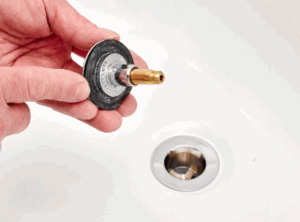
Create A Seal With The Plunger
Creating a tight seal with the plunger over the bathroom sink drain is crucial for generating sufficient suction and pressure to dislodge clogs and blockages, offering a valuable DIY home improvement approach for drain maintenance.
The proper technique involves pressing the plunger firmly over the drain opening and ensuring that there are no air leaks. It’s important to also cover the overflow vent if there is one. Applying a layer of petroleum jelly to the rim of the plunger can help improve the seal. Once the seal is secure, push and pull the plunger in a steady rhythm to create the necessary suction. For tough clogs, combining the plunger with a homemade drain cleaner or hot water can further enhance its effectiveness in clearing the blockage.
Plunge The Drain
Vigorously plunging the bathroom sink drain is a key step in dislodging and clearing clogs, promoting the free flow of water and offering an effective DIY home improvement method for drain maintenance.
This process involves using a plunger to create a strong suction and pressure to dislodge the blockage. Ensure that the plunger covers the drain completely and use vigorous up-and-down motions to generate the necessary force. It’s crucial to maintain a consistent and forceful plunging action for at least 20-30 seconds to effectively clear the obstruction. This method is cost-effective, environmentally friendly, and can prevent the need for costly professional plumbing services.
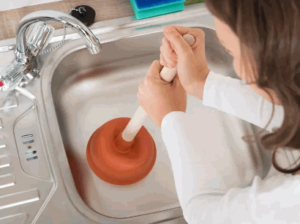
Test The Drain
After using the plunger, it is important to test the bathroom sink drain to ensure the successful removal of clogs and blockages, validating the effectiveness of the DIY home improvement process for drain maintenance.
One method for testing the drain’s functionality is to run hot water for a few minutes to see if it flows smoothly. If the water drains without backing up, it indicates that the plunging was successful.
You can pour a small amount of baking soda followed by vinegar into the drain to further clear any remaining residue. This can aid in maintaining the drain’s cleanliness and preventing future blockages.
How To Clean Bathroom Sink Drain With Drain Snake?
Cleaning the bathroom sink drain with a drain snake involves a methodical approach to removing stubborn clogs, particularly those caused by trapped hair and blockages within the pipes, making it an essential DIY home improvement technique for drain maintenance.
Begin by removing the sink stopper and clearing any visible debris before inserting the drain snake. Carefully maneuver the snake down the drain while turning the handle to dislodge the blockage. Ensure to use gentle, consistent pressure to avoid damaging the pipes. Once the snake reaches the clog, gently pull it back, bringing the obstruction with it. After removing the clog, run hot water through the drain to flush out any remaining debris. Remember to wear gloves and eye protection and always follow safety guidelines when using the drain snake.
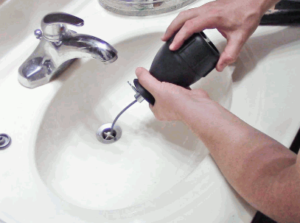
Remove The Drain Stopper
Before utilizing the drain snake, it is essential to remove the drain stopper in the bathroom sink, enabling unobstructed access for maintenance and DIY home improvement activities.
This simple step is crucial as the drain stopper can trap debris and prevent the drain snake from reaching the clog. By removing the stopper, you ensure that the snake can effectively penetrate through the pipes, dislodging any blockages. This facilitates the efficient removal of hair, soap scum, and other buildup, preventing future clogs and maintaining the smooth flow of water in your sink. It’s a fundamental part of maintaining a clean and functional bathroom sink, making it an integral aspect of DIY home improvement projects.
Insert The Drain Snake
Carefully inserting the drain snake into the bathroom sink drain allows for targeted maneuvering to dislodge clogs, particularly those caused by trapped hair and debris within the pipes, making it an effective DIY home improvement approach for blockage removal.
Once the drain snake is inserted, it should be pushed down the drain while turning the handle to navigate through the pipes. It’s important to feel for any resistance, as this could indicate the location of the clog. Slowly maneuver the snake to target the area of blockage, and then gently apply pressure to dislodge the debris. Pull the snake back out carefully, making sure to wipe off any accumulated residue as it’s removed. Repeat the process as needed, clearing the way for a smoothly flowing drain.
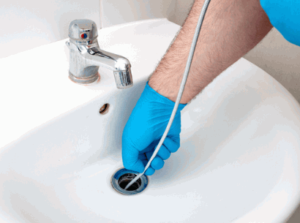
Twist And Push The Drain Snake
Twisting and pushing the drain snake within the bathroom sink drain enables effective engagement with clogs, especially those ensnared by the hair and trapped debris, making it a valuable DIY home improvement technique for thorough blockage removal.
To best utilize the drain snake, one should start by carefully inserting it into the drain and gradually applying pressure while turning the handle. The twisting motion helps the snake to navigate through the clog, while the pushing action assists in dislodging the trapped debris. It’s essential to maintain a steady but gentle force to avoid damaging the pipes.
Once the snake reaches the blockage, maneuver it back and forth to break up the obstruction and create a clear pathway for water flow. With patience and precision, the drain snake can effectively clear away even stubborn clogs, providing a cost-effective and convenient solution for trap clearance and clog removal.
Remove The Debris
After using the drain snake, removing the dislodged debris and blockages from the bathroom sink drain is essential to ensure thorough unclogging and effective DIY home improvement maintenance.
Start by carefully pulling out the snake, ensuring that any remaining debris is dislodged and raised to the surface. Using a pair of gloves, carefully retrieve the extracted debris and dispose of it properly. Follow up by pouring hot water down the drain to flush out any remaining particles and ensure clear passage. This process not only prevents potential reclogging but also promotes a hygienic environment within your home. Completing this maintenance task periodically can significantly improve the efficiency of your drainage system.
How To Clean Bathroom Sink Drain With Baking Soda And Vinegar?
Using baking soda and vinegar to clean the bathroom sink drain involves a natural and eco-friendly solution for removing clogs, eliminating unpleasant odors, and conducting routine DIY home improvement maintenance.
This natural cleaning duo offers an effective, chemical-free alternative to commercial drain cleaners. The effervescent reaction when combining baking soda and vinegar creates a powerful foaming action that helps break down buildup within the drain. The mild abrasive nature of baking soda can dislodge stubborn debris, while vinegar’s acidic properties neutralize foul smells. Together, they present an eco-conscious approach to maintaining clean and odor-free drains without harsh chemicals, making it an ideal method for households looking for sustainable and cost-effective solutions.
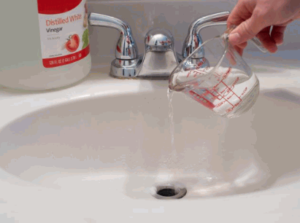
Remove The Drain Stopper
Before applying the baking soda and vinegar solution, it is essential to remove the drain stopper in the bathroom sink, ensuring unobstructed access for maintenance and DIY home improvement activities.
Taking this step allows the solution to reach deep into the drain, breaking down built-up residue and blockages more effectively. Removing the stopper also enables thorough cleaning and prevents any potential chemical reactions with the stopper material.
This simple yet crucial DIY task not only helps in maintaining a clean and functional sink but also promotes efficient water drainage, reducing the risk of clogs and potential plumbing issues in the long run.
Pour Baking Soda And Vinegar Down The Drain
Carefully pouring a mixture of baking soda and vinegar down the bathroom sink drain initiates a natural and effective cleaning process, targeting clogs, grime, and unpleasant odors, aligning with eco-friendly DIY home improvement practices.
The combination of baking soda and vinegar creates a fizzing action, which helps to dislodge debris and break down grime within the drain. This dynamic duo also works to eliminate foul odors by neutralizing and removing bacteria and other impurities. As a natural solution, it avoids the use of harsh chemicals, reducing the environmental impact and making it safe for homes with children and pets. The simple yet powerful reaction of these natural ingredients offers a cost-effective and efficient method for maintaining clean and odor-free drains.
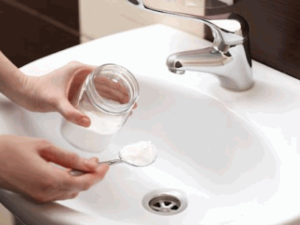
Let It Sit And Fizz
Allowing the baking soda and vinegar mixture to sit and fizz within the bathroom sink drain facilitates a natural and thorough cleaning process, targeting clogs, and odor-causing grime, and promoting eco-friendly DIY home improvement practices.
This simple yet effective method harnesses the power of chemical reactions between baking soda and vinegar, resulting in the formation of carbon dioxide gas. As the solution foams and bubbles, it dislodges and dissolves the buildup of hair, soap scum, and other debris within the drain. This not only helps to swiftly remove clogs but also eliminates unpleasant odors, leaving the drain smelling fresh and clean.
Embracing such natural solutions aligns with sustainable living and reduces dependency on harsh chemical cleaners, making it an ideal choice for environmentally conscious individuals. As the mixture works its magic, it exemplifies the ease and affordability of maintaining a healthy, efficient home environment.
Flush With Hot Water
Flushing the bathroom sink drain with hot water after the baking soda and vinegar treatment completes the natural and eco-friendly cleaning process, ensuring the removal of residual grime, and clogs, and promoting DIY home improvement maintenance.
This final step is crucial in effectively flushing out any remaining debris and ensuring a smooth water flow. Hot water helps to loosen and wash away any leftover particles, providing a thorough cleansing action. It aids in eliminating lingering odors, leaving the drain fresh and odor-free. The heat from the hot water also helps to dissolve any grease or soap scum that may have accumulated, further enhancing the benefits of the natural solutions used earlier. Implementing this simple yet effective step is a great way to maintain a clog-free and well-functioning drain.

